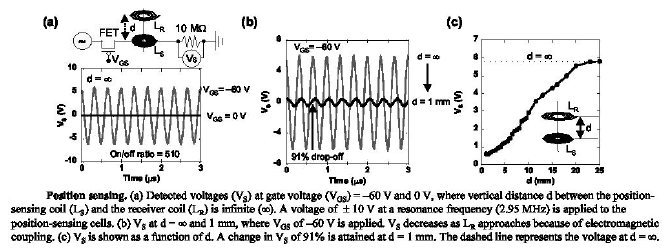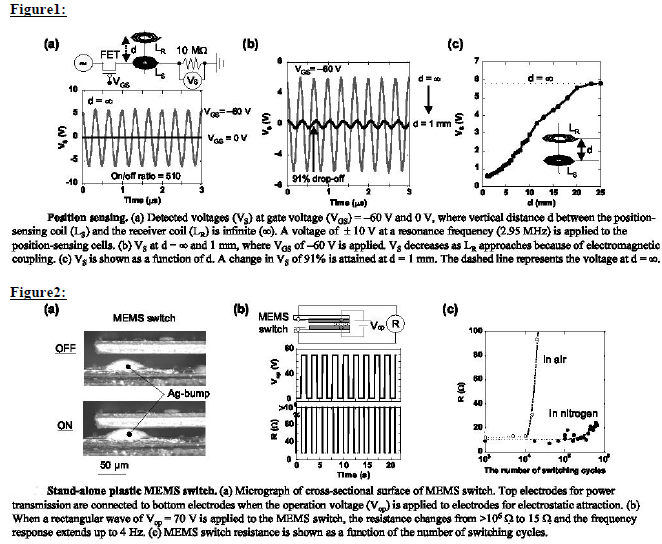|
Manufacture of Wireless Power Transmission Sheet using Printed Plastic MEMS Switches and Organic
Field Effect Transistors
Introduction
Wireless Power Transmission(WPT) is the process that takes place in any system where electric energy is transmitted from a power source to an electrical load, without interconnecting wires in an electric load. This could free cell phones, portable electronics from wired recharging. Moreover, it will lead to reduced reliance on batteries in some electronic devices.
The best known example of transmitting power wirelessly is electromagnetic radiation in the form of radio waves. Such radiation is excellent for wireless transmission of information but it is very inefficient for power transmission. Radio waves spread in all directions, so a vast majority of the power from such a source would be lost to the environment. The most common form of wireless power transfer is carried out using Inductive Power Transfer.
The first WPT experiment was carried out by Nikola Tesla at Wardenclyffe where he transmitted Alternating Current and was able to light lamps over 25 miles away without using wires. High frequency current of a Tesla Coil could light lamps filled with Ne.
The most important breakthrough during World War-II came when scientists developed ability to convert energy to microwaves using magnetron. In 1964, William Brown demonstrated a rectenna which can convert microwave power to electricity. Ubiquitous Power Source Design with Microwave Power Transmission We propose a
Ubiquitous Power Source(UPS) with Microwave Power Transmission
(MPT). For this, we use only carrier of the microwave to transmit the power. Microwave means wireless power transmission via microwave, such as 2.45 GHz-Band and 5.8 GHz-Band as ISM Band. We bring a receiving system, rectenna instead of heavy battery. The safety level must be under 1mW per sq cm. for continuous all over the human body. Against the safety level, we would like to get higher power from the microwave.
For the experiment, we have selected a magnetron and slotted antenna array for the transmitting system of the UPS. We use new rectenna array, receiving system for the microwave power transmission with higher efficiency under 1mW per sq cm microwave input. We adopted a Dual polarized antenna for the rectenna in order to |
|
catch the microwave power from everywhere. The experiment will be done in the shielded room
Design Target
For carrying out laboratory experiment of the UPS, we set a design target as follows:
1. Frequency= in ISM Band ex. 2.45 GHz
2. Input Electric Power 1w
3. Keep Safety level(1 mW per sq cm)
4. Power density= Approx. Uniform
5. Economical System for promotion.
We chose the MPT system with 2.45 GHz magnetron & Waveguide Slotted Antenna for the experiment. The UPS is a better system to generate stable electric power in any condition than the solar cell
Estimation of Power Density level by FDTD Method
Firstly we simulate the microwave power density in the shielded room by FDTD method. From the fig.1, the size of the room is 3.0 X 5.8 X 4.3 cm. and is shielded. From the antennas in edges of the ceiling,
Transmitting System

Fig:1 Concept of Ubiquitous Power Source
we emit the 2.45 GHz CW microwave. If we don’t consider the power loss by air and the wall with conductor, the emitted microwave power will be accumulated and will be finally diffused. Therefore, we assume the power loss by air & the wall with conductor and estimate validity of the simulation. We conclude the simulation with loss leads valid results. |

We now confirm that approximate power density was realized.
We now adjust the total emitted microwave power in the condition that maximum power density was under 1 mW per sq cm.
Power Density in the Shielded room by FDTD Simulation

Experimental setup of the Ubiquitous Power Supply System



In this way, Ubiquitous Power Source is constructed.
Manufacture of Wireless Power Transmission sheet using Printed Plastic MEMS Switches and Organic Field Effect Transistors
This paper is about manufacturing a large-area flexible wireless power transmission sheet using Printed Plastic MEMS Switches and Organic Field Effect Transistors. The position of Electronic objects on this sheet can be contactlessly sensed by electromagnetic couplings using an organic transistor active matrix. Power is selectively fed to the objects by an electromagnetic field using a plastic MEMS switching matrix. The System realizes a low-cost sheet-type wireless power source of more than several watts. This is the first step towards building infrastructure for ubiquitous electronics, where multiple electronic objects are scattered over desks, floors, wall and ceilings and need to be powered. These objects may be mobile or located in the dark
Device Manufacturing Process |
|
And, therefore solar cells can’t be used to power them. The proposed WPT Sheet will directly drive electronic objects or charge a rechargeable battery in the objects without a connector.
The wireless power transmission sheet has been manufactured on a Plastic Film by using Printing Technologies. The effective power transmission area is 21 X 21 sq cm. The sheet contains a twodimensional array of 8 X 8 cells comprising position sensing and power transmission units. The position of electronic objects on the sheet can be contactlessly sensed by electronic coupling, using an organic transistor active matrix. Then, power is selectively fed to the objects by an electromagnetic field using a two-dimensional array of copper coils, that are driven by a Printed Plastic MEMS-Switching Matrix. Due to selective Power Transmission, a coupling efficiency of Power Transmission of 62.3% and a Power of 29.3W was received. Device Manufacturing |

| The entire system comprising 8 X 8 cells is manufactured by integrating the Position-sensing & Power Transmission Sheets. The periodicity is 25.4 mm. The contactless Position-sensing sheet comprises sheets of the Position-sensing coil array and Organic FET Active Matrix. An Organic FET Organic Active Matrix is fabricated on a Polyimide Film. Silver Gate Electrodes & Polyimide Gate Dielectric Layers are patterned by using inkjet printing. A Pentacene Channel Layer and Gold |
|
The channel length & width are 13 µm and 48 µm, respectively. A Position-Sensing Coil Array is manufactured by screen printing. The inner diameter of the copper coils is 10 mm. Both the width & spacing of the copper lines are 100 µm. The no. of turns is 38. The inductance & resistance are 20 µH & 17 O respectively. |

The power transmission sheet comprises sheets of the Printed Plastic MEMS-Switches matrix and Power Transmission Coil array. The power transmission coil array comprises copper coils with an inner diameter of 10 m. Both the width & spacing of the copper lines are 300 µm. The no. of turns is 13. The inductance & resistance are 3 µH & 17 O respectively. 
A MEMS Switching Matrix is formed by using inkjet printing and screen printing. The electrodes for power transmission and those for electrostatic attraction are patterned on a 25 µm thick Polyimide membrane.
Device Characteristics
The contactless position sensing sheet: The Pentacene transistors in DC Characterization exhibit
Following are the experimental diagrams:
Figure1:
|
|
mobility of 1 sq cm./Vs and an on/off ratio of 10000/1. A voltage of ±10 V at a resonance frequency(2.95 MHz) is applied to the position sensing coils. The on/off ratio of the transistors at 2.95 MHz exceeds 500. When the distance between the position sensing coils and the receiver coil reduces, the change in output voltage increases and reaches 91%.
|


In this way, Wireless Power Transmission sheet is manufactured which is a great technological advancement for our mankind.
|












